table of content
- Introuduction
- ChatGPT in Practice: Real-World Applications
- Major Updates and Milestones in ChatGPT’s Development
- features and pricing of chatgpt
- How to Access and Use ChatGPT: A Comprehensive Guide
- training process of custom GPT’s
- Benefits of Customization and Training
- Practical Use of Custom GPT’s
- conclusion
Introuduction
Imagine a world where technology doesn’t just compute but converses, understanding and generating language with an ease that blurs the lines between human and machine. Welcome to the world of ChatGPT, a groundbreaking AI bot chatting platform shaping this very reality.
ChatGPT, a remarkable achievement in artificial intelligence tools, stands as a symbol of innovation in natural language processing. Developed by OpenAI, an organization founded by visionaries like Elon Musk, Sam Altman, Peter Thiel, and Reid Hoffman, and led by researchers including Ilya Sutskever and Dario Amodei, this AI chat bot represents more than just technical skill; it showcases a transformative vision for digital intelligence.
From its early stages as a developing language model, ChatGPT has evolved dramatically, representing not just a significant advance in AI capabilities but a major shift in how we interact with machines. Its journey from a fascinating experiment to an advanced AI essay writer and conversational partner marks a series of substantial technological advancements.
As we embark on this exploration, we’ll delve deep into ChatGPT’s origins, its evolution, and its vast array of functionalities. From businesses leveraging its capabilities for customer interactions to content creators finding an invaluable assistant in their creative processes, ChatGPT’s influence is widespread. We’ll also look at how it can be customized and trained for specific needs, providing an insight into the future of personalized AI experiences.
Join us as we explore the complex network of ChatGPT’s development, applications, and future potential. Whether you’re an AI enthusiast, a small business owner, or just curious about the best AI apps, this journey through the world of ChatGPT promises to be as informative as it is captivating.
ChatGPT in Practice: Real-World Applications
In the constantly changing world of artificial intelligence, ChatGPT stands out with its advanced AI capabilities. This powerful tool offers a wide range of functionalities that go far beyond basic conversation, meeting diverse needs in various areas. From creative projects to technical solutions, ChatGPT’s flexible nature shows the potential and adaptability of AI in our everyday lives.
1. Content Creation
In the world of content creation, ChatGPT is a great ally. It helps creators in many ways, from generating ideas and drafting content to refining language and style. For instance, content creators can ask ChatGPT to create outlines for essays or blog posts, fill out these outlines with content, and even find sources for further research. It can also co-edit writing, finding errors and suggesting improvements, thus speeding up the editing process.
ChatGPT has been used to generate emails with a professional voice, plan marketing campaigns, and conduct keyword research for SEO. It can even generate scripts for TikTok and Instagram Reels, providing a steady stream of content ideas for social media marketers. Additionally, it has been employed to create content calendars, helping with the scheduling of posts across various platforms.
2. Business Applications
As a business owner, you’ll find that ChatGPT offers solutions to automate customer inquiries, craft marketing copy, and streamline communication tasks. It’s an essential element in conversational commerce strategies, improving customer engagement and satisfaction through quick responses.
Exemples:
Several businesses have successfully integrated ChatGPT into their operations. For example:
- HelloFresh used a chatbot for quizzes and surveys, leading to reduced response times and increased message volume.
- Woebot, a therapy chatbot, employs cognitive-behavioral therapies to deliver messages, showing substantial advantages in a study involving college students with depression.
- Landbot.io offers businesses a no-code chatbot builder, aiding in converting leads into customers with a reported success rate of 90%.
- Dominos uses a chatbot for simplifying pizza orders, allowing customers to place orders and customize them through the bot.
- Emirates Airlines created a chatbot for travel recommendations, increasing customer engagement by 87% during a 30-day test compared to traditional display advertisements.
3.Technical Assistance
For developers and tech enthusiasts, ChatGPT provides coding help, debugging assistance, and explanations of complex algorithms. It’s your go-to resource for technical problem-solving and learning!
4.Educational Aid
ChatGPT is like your educational buddy, breaking down tough topics and practicing language with you. It makes learning more engaging, offering accessible and interactive support.
These AI tools, with their unique features and advancements in 2023, demonstrate the diverse applications of AI in content creation, business operations, and personal assistance. Their evolution also hints at the potential growth trajectory for AI in 2024, further revolutionizing how we interact with technology in our daily lives.
Major Updates and Milestones in ChatGPT’s Development
ChatGPT’s journey is a great example of ongoing innovation. Each update isn’t just a technical milestone, but also a step towards a more intuitive and responsive AI.
Chatgpt updates
Let’s trace ChatGPT’s evolution, starting from its initial version to the latest iteration.
- GPT-1 (June 2018): OpenAI’s first transformer-based language model with 117 million parameters, capable of tasks like textual alignment and sentiment analysis.
- GPT-2 (February 2019): Featured 1.5 billion parameters and broader task capabilities, trained with internet data. OpenAI initially held back its full release due to misuse concerns.
- GPT-3 (2020): A significant jump to 175 billion parameters, offering more powerful capabilities. GPT-3 was the first model to be fine-tuned, with public API access provided by OpenAI.
- InstructGPT (January 2022): A fine-tuned version of GPT-3, focusing on reducing offensive language and misinformation.
- GPT-3.5: Further fine-tuned for understanding and generating natural language and code.
- ChatGPT (November 2022): Released with capabilities almost identical to InstructGPT, trained using Reinforcement Learning from Human Feedback (RLHF).
- GPT-4 (March 2023): This version significantly improved ChatGPT’s capabilities, especially for complex tasks. It introduced a larger context window and more accurate information processing.
- Code Interpreter (July 2023): Based on GPT-4, it understands and generates outputs in multiple formats, marking a substantial leap in AI versatility.
Each major update has broadened ChatGPT’s applications across different fields, bolstering its role in content creation, business, and other sectors where accuracy and deep understanding are vital. This ongoing journey of improvement paves the way for future AI innovations, with possibilities as boundless as the technology itself.
Features and pricing of ChatGPT
ChatGPT, developed by OpenAI, has evolved into a versatile AI tool with a range of functionalities that significantly extend its utility beyond simple conversation. Let’s take a closer look at some of its key features:
Features
1. Advanced Data Analysis
The latest version of ChatGPT, GPT-4, now comes with an Advanced Data Analysis feature exclusively for premium accounts. With this functionality, users can directly upload data to ChatGPT for writing and testing code. It supports various file formats like text, images, full documents, and code or data files, making it perfect for exploring data, creating code, and solving real-world problems with AI assistance. This feature significantly improves the accuracy and usefulness of the AI’s output.
2. Web Browsing
ChatGPT now has a web browsing feature with a user interface that resembles the Edge Browser. This means you can keep an eye on every step of your browsing, making sure you get the latest and most relevant results. This feature ramps up ChatGPT’s interactive skills, making it better at finding and showing information from the web.
3. Plugins
The introduction of plugins has revolutionized the way users interact with ChatGPT. Users can now:
- Access and install plugins from the Plugins store.
- Manually trigger actions with installed plugins, such as sending messages to Discord servers or dumping information into Notion notes.
- Integrate real-time interactions with third-party tools like Twitter, Facebook, Instagram, and many others, thereby streamlining and automating activities.
4. Integration with External APIs:
ChatGPT’s ability to integrate with external APIs opens up a world of possibilities. It can fetch real-time data, perform complex calculations, and even control smart devices. This functionality bridges the gap between AI and the digital world, enabling seamless interactions and data processing. For example, an engineer at PacketFabric used ChatGPT to generate a script for interacting with their API, showing how it can handle complex tasks and assist in refining outputs.
5. Image Generation with DALL-E:
Teaming up with DALL-E, ChatGPT now delves into visual creativity. It can craft stunning images and artwork from textual descriptions, offering artists and designers a unique tool to bring their visions to life.
6. Training custom GPT :
Users create custom versions of ChatGPT, known as GPTs, for specific purposes. Whether it’s generating unique content or handling specialized tasks, GPTs can be configured to browse the web, generate images, or even run code. This flexibility allows people to leverage AI for tasks tailored to their specific needs.
7. Multi-GPT Conversations:
This advanced feature lets you interact with multiple GPT models all at once in a single conversation.
8. GPT Store :
OpenAI is on the brink of a major breakthrough in the field of artificial intelligence with the launch of the GPT Store. This new platform marks a bold move towards making AI technology more accessible, allowing people to create and earn from their own versions of ChatGPT.
pricing planes
1. Free Version
The Free Version of ChatGPT is perfect for individuals exploring AI or those with occasional usage needs. This tier usually includes:
- Basic ChatGPT functionalities.
- Limited number of daily queries or interactions.
- Standard response time and processing capabilities.
2. ChatGPT Plus
ChatGPT Plus is a subscription-based model aimed at regular users seeking enhanced capabilities, it costs 20$/month . Features of this tier often include:
- Priority access to new updates and features.
- Faster response times and improved performance.
- Increased query limits and enhanced processing power.
- Advanced features such as chatgpt-4, imege generation with DALL-E, custom GPT and plugings.
3. ChatGPT Team
Designed for businesses and organizations, the ChatGPT Team plan offers enterprise-level features and support, this plane costs 25$/month. Key aspects may Include:
- Multi-user account access and centralized billing options.
- Advanced administrative and user management tools.
- Customization to suit specific business needs and workflows.
- Priority customer support and dedicated service channels.
4. ChatGPT Enterprise
ChatGPT Enterprise is designed for businesses seeking advanced AI solutions with enhanced support and security. This plan usually includes:
- Tailored ChatGPT versions to suit specific business requirements.
- Additional layers of security to protect sensitive data and interactions.
- Dedicated customer service and technical support.
- Options to scale up AI capabilities as the business grows.
- Easy integration with existing business systems and workflows.
Pricing: The pricing for ChatGPT Enterprise typically varies based on the level of customization and usage requirements. Businesses interested in this plan can contact OpenAI’s sales team for a tailored quote.
5. ChatGPT API
The ChatGPT API is aimed at developers and businesses looking to integrate ChatGPT’s capabilities into their own applications and services. Key features often include:
- Direct access to ChatGPT functionalities through an API.
- Ability to integrate AI capabilities into various applications and platforms.
- Options to tailor the AI responses and functionalities to specific use cases.
- Plans that accommodate varying levels of API calls and usage intensity.
for mor detailles about how to use API visit this article
Pricing: The pricing for the ChatGPT API is typically based on the number of tokens you use where 1000 tokens equals 750 words, and the price varies from 0.0001$/1k tokens to 0.12$/1k tokens depending on the vesion of gpt you will be using
How to Access and Use ChatGPT: A Comprehensive Guide
Step-by-Step Guide to Access
Website or Platform Access
ChatGPT can be easily accessed through the OpenAI website. For new users, here’s a simple guide:
- Visit the OpenAI website.
- Look for the ChatGPT section.

- If you’re a new user, you’ll need to sign up. Existing users can simply log in.
- Once logged in, you’ll be directed to the ChatGPT interface.
Getting Started with ChatGPT
To begin interacting with ChatGPT:
- Enter a simple greeting or question in the chat interface.
- ChatGPT responds to natural language, so there’s no need for formal or technical phrasing.
- Experiment with different types of queries to understand the AI’s range.

For those who are more experienced:
- Explore memory capabilities for more contextual conversations.
- Adjust the tone and style of responses via settings or specific commands.
Tips for Effective Communication
Effective communication with ChatGPT ensures better and more accurate responses. Here are some tips:
- Be clear and specific with your queries.
- Provide context where necessary.
- If the response isn’t satisfactory, try rephrasing your question.
Dive into advanced AI techniques – check out our blog on ChatGPT’s advanced prompt templates now!
training Process of custom GPT's
Step 1: Building Your Custom ChatGPT
1.Account Requirements
To start building a custom GPT, you must have a ChatGPT Plus or Enterprise account with OpenAI.
2. Accessing the Builder :
Go to chat.openai.com and log in. Navigate to the sidebar and click on ‘Explore’ followed by “Create a GPT”.
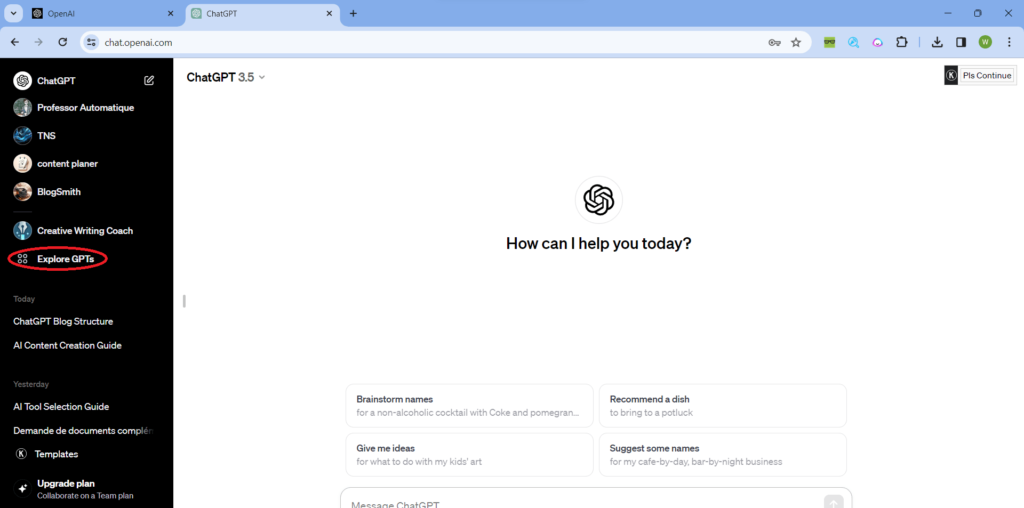
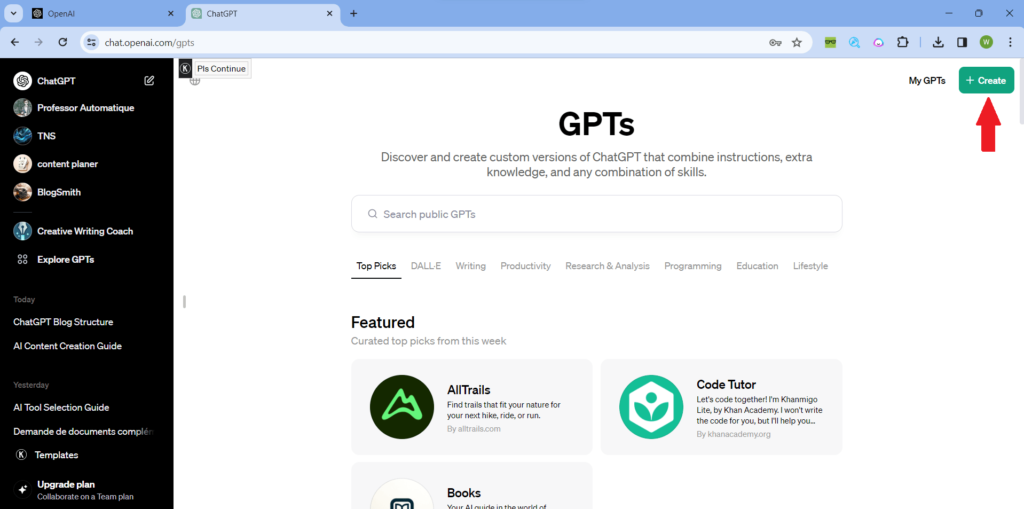
3. Creating Your GPT:
On the Create page, enter your specific instructions and interact with the GPT builder. This interface guides you in defining the desired attributes and functionalities of your custom GPT.

Step 2: Refining Your GPT
1. Fine-Tuning Instructions:
The GPT builder will prompt you for more specific instructions to fine-tune your chatbot’s behavior. This might involve adjusting response lengths, ensuring factual accuracy, or any other behavioral aspect relevant to your needs.
2. Testing and Refining
Continuously interact with your custom GPT in the Preview panel. Test its responses and refine the instructions based on the outcomes. This iterative process helps in shaping the chatbot to produce the kind of responses you aim for.
Step 3: Advanced Customizations
1. Configuring Your GPT
After setting up the basic instructions, delve into advanced customization. You can change your chatbot’s name, profile picture, add mor custom instruction and even upload knowledge source files for more context-specific responses.

2. Adding Capabilities:
The custom GPT can be enabled to perform web browsing, image generation, code execution, and data analysis. This is done through the ‘Configure’ option, where you can also add specific actions or integrate third-party APIs for extended functionalities.
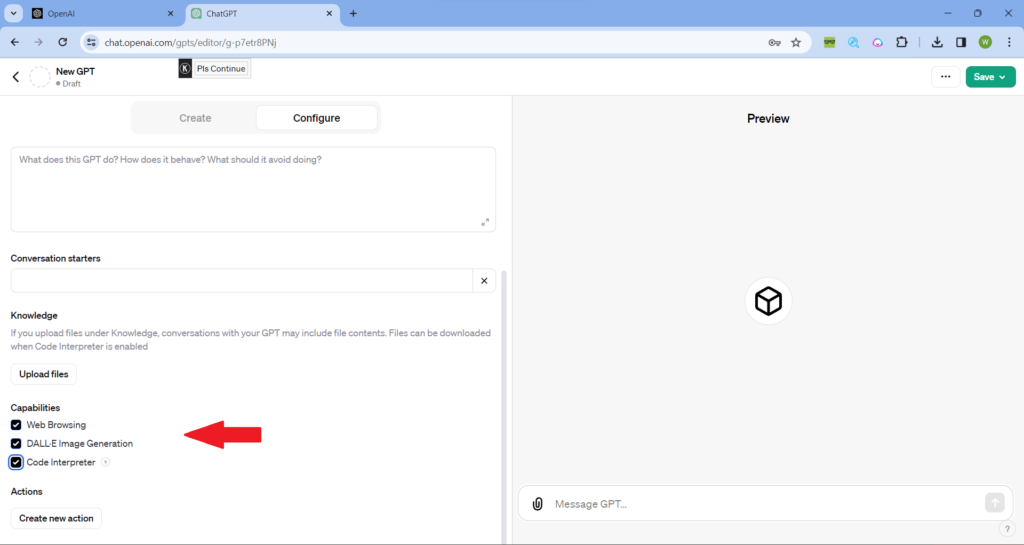
Step 4: Deployment and Sharing
1. Saving Your Custom GPT:
Once satisfied with the customization, save your GPT. You can then select how you want to share your custom GPT, whether for personal use, within your organization, or publicly.
2. Sharing Your GPT:
The custom GPT can be shared based on your preference, ensuring that the right audience has access to this tailored AI tool.
Benefits of Customization and Training
Customized ChatGPT models offer more accurate and relevant responses, enhancing user experience and efficiency in specialized applications. This customization ensures that ChatGPT responds appropriately to specific tasks, making it a valuable tool across various professional contexts.
By customizing and training, ChatGPT goes beyond its general AI role to become a specialized tool ready to take on unique challenges. This adaptability is crucial for unleashing ChatGPT’s full potential across various applications.
Practical Use of Custom GPT's
In the ever-changing world of AI, using custom GPTs for specific tasks provides a powerful tool for personal and professional use. Picture incorporating multiple custom GPTs into a single conversation, demonstrating their practical application in a dynamic and interactive way.
Step 1: Choose a Custom GPT and Initiate Conversation
Scenario: Imagine you’re working on a project that involves writing an engaging blog post about the latest AI trends. For this, you turn to a custom GPT specialized in blog writing.
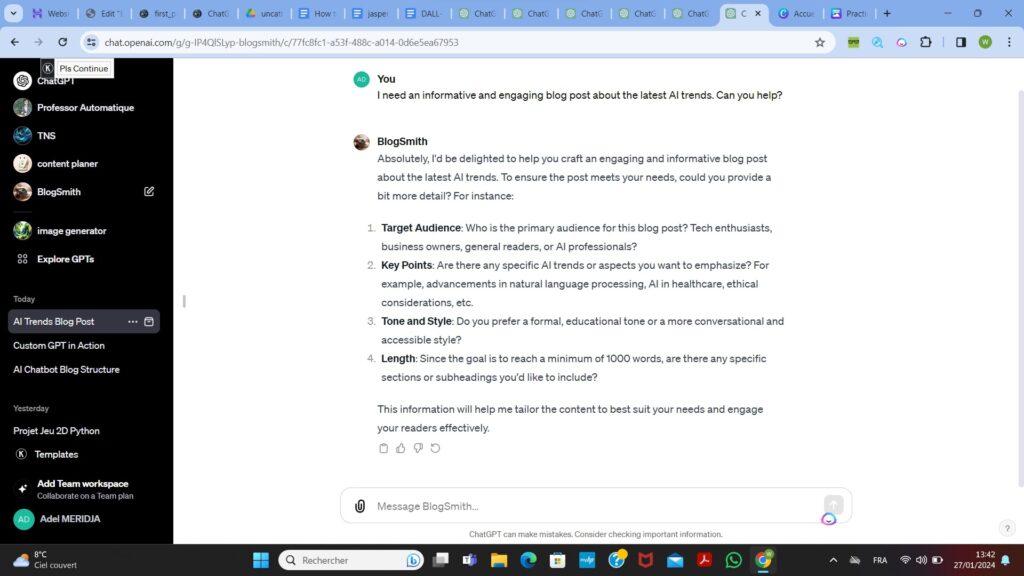
Step 2: Incorporate DALL-E for Visual Content
Scenari: As we craft our written content, we understand the importance of unique, custom visuals to enhance the blog post. We use the image generator by typing “@image generator” in the message area, a custom GPT model known for its ability to produce beautiful, relevant images based on textual descriptions.

Conclusion
The launch of the GPT Store by ChatGPT marks a pivotal moment in AI’s journey towards more personalized and efficient digital solutions. This is a game-changer, opening doors to a new era of innovation and streamlined processes.
If you’re fascinated by the evolving capabilities of AI, don’t miss our insightful guide on ChatGPT prompt templates. It’s packed with valuable tips to enhance your AI experience. Dive in, and discover how these templates can revolutionize your approach to content creation.
Let’s embrace this exciting journey into the future of AI together!
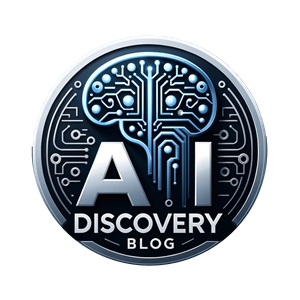





[…] asset for content creators needing to produce large volumes of written content efficiently. Check this blog to have more informations about […]
[…] deeper into the capabilities and nuances of ChatGPT on our blog. Read on to explore how this technology is revolutionizing Content Creation and what it could mean […]